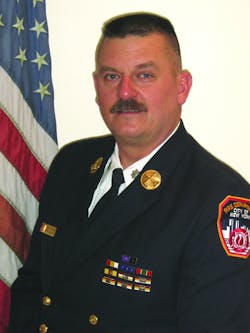The Fire Scene: Engine Company Initial Fire Attack
I’ve talked before about the vital work that engines perform at structure fires. In this article, I’d like to talk specifically about the initial fire attack—the portion of the structural fire operation where the engine company enters the building with an attack hoseline and actually fights the fire.
On the scene of a structure fire, as we know, several firefighters are simultaneously performing several different tactics, all of which are important and often have a bearing on the success of the others. In spite of the fact that some tactics are more glamorous and attract more attention from the occupants and the local newspaper reporter, all the work that the engine does is vital; in other words, it’s really important. You can’t live without it—like oxygen in a space capsule. You understand now, right?
Three’s company?
So your engine crew has selected and is pulling in the appropriate pre-connected hoseline to the front door of a private dwelling. The fire is located on the second floor of this structure and is venting out two windows in the rear. A truck company arrived along with your engine, and the inside team has already entered the house to conduct a search. Your engine crew is stretching the hoseline toward the front door of the house, and the engine officer is listening to the ladder company officer's radio transmissions. The engine officer takes a quick look around, and he can see that the nozzle is just about at the door. He can also see the engine company chauffeur at the apparatus just completing the supply line connection to the engine.
Two firefighters are now at the front door with the officer and are ready to move in with the attack hoseline. Should the officer take in both of them for this operation?
Two in, two out
With three firefighters and an officer, it might make sense to take just one firefighter in and leave the other two at the door. Remember: We’re entering a private house. That means we should be stretching a small attack line, such as a 1 3/4" or 1 1/2" line, which can be easily accomplished by two people.
Now, the one drawback here is this: When the officer and a single firefighter enter a building with a hoseline for fire attack, the firefighter will handle the nozzle and the officer will have to perform the back-up duties. This will, to some degree, distract or sidetrack the officer from their vital company officer duties: monitoring conditions, communicating with command and encouraging the nozzle firefighter. On the other hand, it allows the other two firefighters left at the front door to lighten up on the line, remain available to enter and assist the first team, if necessary, and remain intact and available to relieve the first nozzle team when requested.
Moving in
So now we’re ready to move in. SCBA facepieces and gloves are on, and the officer calls for water. We’ve talked before about when to charge the attack line; for house fires, the front door is the best place to do this. Dragging a dry line into a burning house is, first and foremost, dangerous because the line can get caught or snagged under furniture or interior doors when it’s flat.
When ready, make sure the nozzle firefighter bleeds the line right there at the front door to get rid of any accumulation of air in the hoseline. If an adjustable nozzle is being used, this is also the moment to make sure it’s in the straight-stream position.
So now we’re on our way up the stairs. We make a turn in the direction of the fire, or progress as instructed by the ladder company. The nozzle team is now at the door to the fire room, which is a large bedroom, and the fire is going strong. The truck was holding the door closed, and the officer and nozzle firefighter move up and prepare for the attack.
Nozzle work
The door should be opened slowly, with the nozzle firefighter ready to immediately open the line. When opened, the nozzle should be directed upward toward the ceiling and opened fully. The stream should be whipped around clockwise or back and forth to distribute the water as widely as possible. The nozzle should also be directed both left and right to further extend the distribution of the water to the far reaches of the room. This should all take place rather quickly. The nozzle should then be shut down momentarily to allow the team to view the room, check the effect the hoseline has had on the fire, and determine the areas that need further water application. Move in a few feet, if possible, before opening the nozzle again, and get properly positioned to finish extinguishing the fire.
Until next time
Of course, there’s more we need to do, but the initial fire attack is complete. In a future article, I’ll take a further look at vital engine operations.
About the Author
John J. Salka Jr.
Battalion Chief
JOHN J. SALKA JR., who is a Firehouse contributing editor, retired as a battalion chief with FDNY, serving as commander of the 18th battalion in the Bronx. Salka has instructed at several FDNY training programs, including the department’s Probationary Firefighters School, Captains Management Program and Battalion Chiefs Command Course. He conducts training programs at national and local conferences and has been recognized for his firefighter survival course, “Get Out Alive.” Salka co-authored the FDNY Engine Company Operations manual and wrote the book "First In, Last Out–Leadership Lessons From the New York Fire Department." He also operates Fire Command Training, which is a New York-based fire service training and consulting firm.

